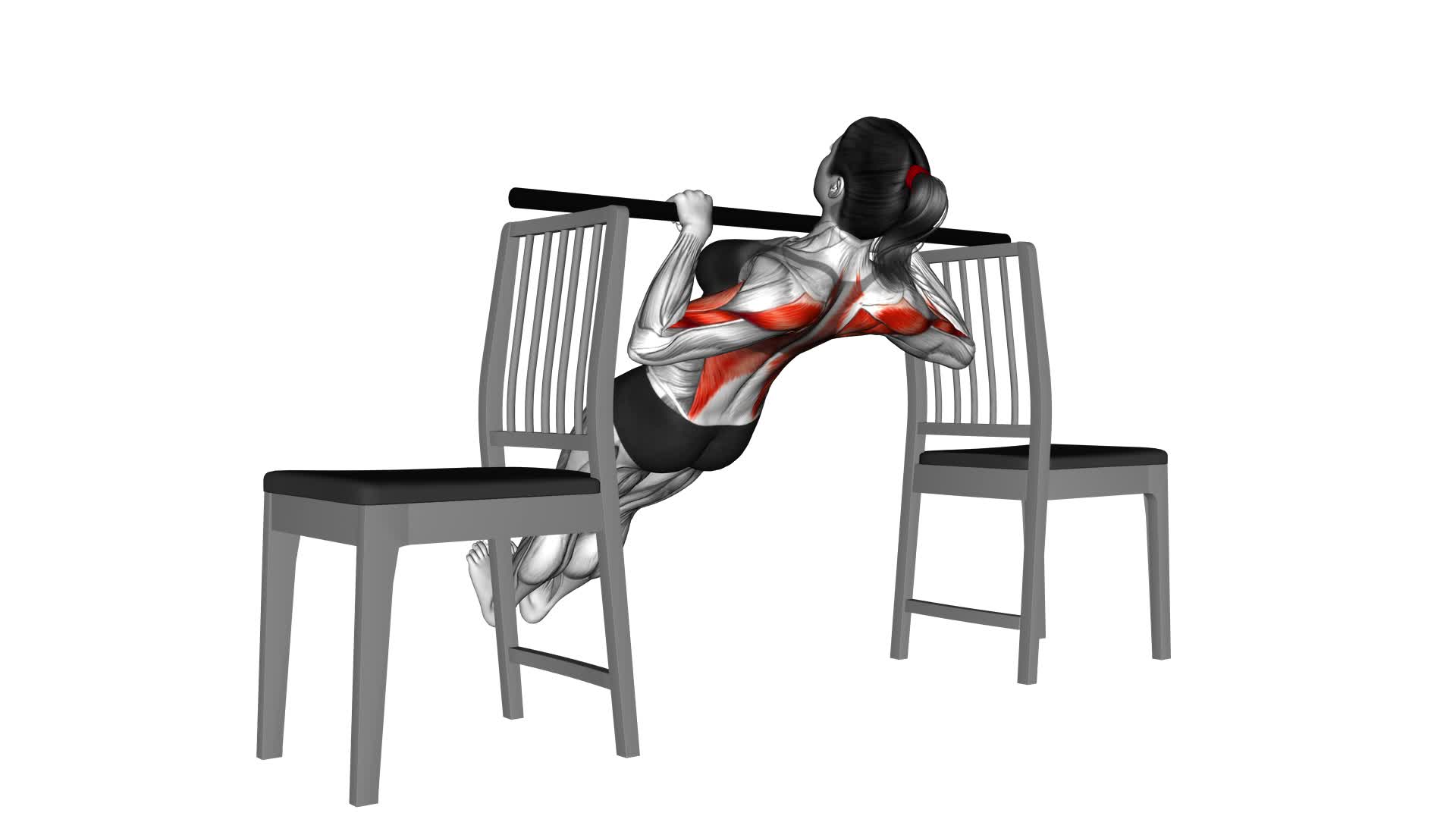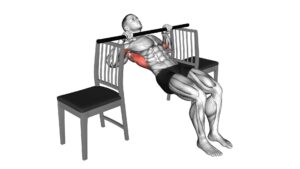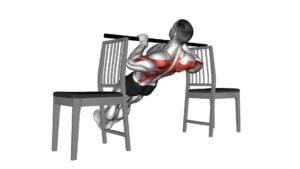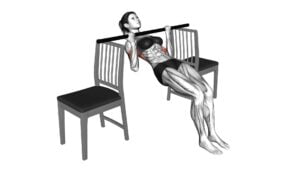Inverted Row Between Chairs (Female) – Video Exercise Guide & Tips

Looking to strengthen your back muscles? In this video exercise guide, we'll show you how to perform the inverted row between chairs.
Watch This Exercise Video
With just a few simple steps, you can set up and position yourself correctly. Avoid common mistakes, challenge yourself, and progress with this effective exercise.
Watch the video and get ready to feel the burn. Let's get started!
Key Takeaways
- The inverted row is a compound exercise that strengthens the back muscles and engages the biceps, forearms, and core for stability.
- Variations of the inverted row include bent-knee and straight leg variations, as well as elevating the feet on a bench or stability ball.
- Proper form and technique are crucial for performing the inverted row correctly, including keeping the body straight and aligned and avoiding common mistakes like using momentum or shrugging the shoulders.
- To progress and challenge yourself, you can add resistance with weights or try advanced variations like the single-arm inverted row or feet elevated inverted row. However, it's important to prioritize safety and proper form and listen to your body to avoid discomfort or injury.
Equipment Needed for Inverted Row
To perform the Inverted Row between chairs, you'll need the following equipment: two sturdy chairs placed parallel to each other, approximately shoulder-width apart. This exercise is a great way to target your upper body muscles and improve overall strength.
The inverted row primarily works your back muscles, including the latissimus dorsi, rhomboids, and trapezius. It also engages your biceps, forearms, and core muscles for stability.
The benefits of the inverted row for upper body strength are significant. By performing this exercise regularly, you can develop a strong and defined back, improve posture, and enhance overall upper body strength. It can also help to reduce the risk of back pain and improve your performance in other exercises, such as pull-ups and push-ups.
There are variations of the inverted row that cater to different fitness levels. Beginners can start with a bent-knee variation, which reduces the load on the muscles and allows for easier execution. As you progress, you can increase the difficulty by straightening your legs or elevating your feet on a bench or stability ball.
Proper Setup and Positioning
For proper setup and positioning of the Inverted Row between chairs, position yourself between the two sturdy chairs, ensuring they're parallel and shoulder-width apart. This will provide a stable base for the exercise and help you maintain proper form throughout.
Here are some key points to keep in mind:
- Keep your feet hip-width apart and flat on the ground. This will help you maintain balance and stability during the exercise.
- Grip the sides of the chairs firmly with your hands, slightly wider than shoulder-width apart. This will engage your back and arm muscles effectively.
- Keep your body straight and aligned from head to toe. Avoid arching or rounding your back, as this can lead to injury and reduce the effectiveness of the exercise.
By setting up correctly, you can avoid common mistakes during the inverted row, such as using momentum to complete the movement or allowing your shoulders to shrug up towards your ears.
The benefits of the inverted row include strengthening your back, arms, and core muscles, improving posture, and enhancing overall upper body strength.
With proper setup and positioning, you're now ready to move on to the step-by-step guide for performing the inverted row and maximizing the benefits of this exercise.
Step-By-Step Guide for Performing the Inverted Row
Now that you have properly set up and positioned yourself between the chairs, it's time to learn how to perform the inverted row step-by-step.
- Grab the edges of the chairs with an overhand grip, making sure your palms are facing away from you. Your arms should be fully extended.
- Keep your body straight and engage your core muscles.
- Begin the exercise by pulling your chest up towards the chairs, squeezing your shoulder blades together. Keep your elbows close to your sides.
- Continue pulling until your chest touches the edge of the chairs.
- Slowly lower yourself back down to the starting position, fully extending your arms.
- Repeat the movement for the desired number of repetitions.
- Remember to breathe throughout the exercise, inhaling as you lower yourself and exhaling as you pull your chest up.
The inverted row provides several benefits, including strengthening your upper back, shoulders, and arms. It also engages your core muscles, promoting stability and balance.
There are variations of the inverted row that you can try to target different muscle groups. For example, you can use a wider grip to emphasize your back muscles, or a close grip to focus on your biceps. You can also elevate your feet on another chair or bench to increase the difficulty and engage your lower body. Explore these variations to add variety to your workout routine and challenge yourself.
Common Mistakes to Avoid During the Exercise
Avoid these common mistakes when performing the inverted row between chairs:
- Incorrect chair placement: Placing the chairs too far apart or too close together can compromise your form and make the exercise less effective. Ensure that the chairs are positioned shoulder-width apart and are stable enough to support your weight.
- Improper body alignment: Maintaining proper body alignment is crucial for a successful inverted row. Avoid arching your back or sagging your hips, as this can strain your lower back and reduce the effectiveness of the exercise. Instead, focus on keeping your body in a straight line from head to heels throughout the movement.
- Neglecting scapular retraction: One of the key benefits of the inverted row is its ability to strengthen the muscles responsible for scapular retraction. However, many people fail to properly retract their shoulder blades during the exercise. Be sure to squeeze your shoulder blades together as you pull your chest towards the chairs, engaging the muscles of your upper back.
By avoiding these common mistakes and focusing on proper form correction, you can maximize the benefits of the inverted row between chairs.
Now, let's move on to the next section, where we'll discuss tips for progressing and challenging yourself with this exercise.
Tips for Progressing and Challenging Yourself With the Inverted Row
To challenge yourself and progress with the inverted row, try adding resistance by using a weight plate or wearing a weighted vest. These progression methods will help you continue to build strength and improve your overall fitness level. Incorporating additional resistance into the exercise will make it more challenging and force your muscles to work harder. Start by adding a small weight plate or wearing a lightweight weighted vest. As you become more comfortable, gradually increase the weight to continue challenging yourself.
In addition to adding resistance, there are advanced variations of the inverted row that you can incorporate into your workout routine. One such variation is the single-arm inverted row, where you perform the exercise with only one arm. This variation increases the demand on your muscles and requires greater stability and core strength.
Another advanced variation is the feet elevated inverted row, where you place your feet on an elevated surface such as a bench or box. This variation targets your upper back and shoulders even more intensively.
Remember to always maintain proper form and technique while performing the inverted row and its variations. Progress gradually and listen to your body to avoid injury. By incorporating these progression methods and advanced variations, you can continue challenging yourself and achieve greater strength and fitness gains with the inverted row exercise.
Frequently Asked Questions
How Many Sets and Repetitions Should I Do for the Inverted Row?
To progress in the inverted row, it's important to determine the right sets and repetitions for your fitness level. Start with 3 sets of 8-12 reps, focusing on proper form and control.
As you get stronger, gradually increase the intensity by adding more sets or reps. Avoid common mistakes like using momentum or arching your back.
Remember to listen to your body and adjust the workout accordingly.
Can I Perform the Inverted Row Exercise Without Chairs?
Yes, you can perform the inverted row exercise without chairs. There are alternative equipment and modifications you can make.
For example, you can use a suspension trainer or a barbell set at a lower height. These options allow you to still target your back, shoulders, and arms effectively.
Remember to maintain proper form and engage your core throughout the exercise.
Is the Inverted Row Suitable for Beginners?
Yes, the inverted row is suitable for beginners. It's a great exercise for building upper body strength.
If you don't have chairs, you can modify the exercise by using a sturdy bar or a suspension trainer.
The inverted row targets your back, shoulders, and arms, helping to improve posture and build muscular endurance.
Start with a comfortable grip and gradually increase the difficulty as you get stronger.
How Long Should I Rest Between Sets of Inverted Rows?
To ensure optimal results and prevent injury, it's crucial to consider rest time between sets of inverted rows.
Resting allows your muscles to recover and replenish energy. The ideal rest time for inverted rows is typically around 60-90 seconds.
However, listen to your body and adjust accordingly. Remember to maintain proper form throughout the exercise, as this is key to maximizing the benefits and minimizing the risk of injury.
Can the Inverted Row Help Improve My Posture?
The inverted row is a great exercise for improving your posture and targeting specific muscle groups. By strengthening your back muscles, it can help alleviate back pain and promote better alignment.
This exercise engages your lats, rhomboids, and biceps, which all play a role in maintaining good posture. Incorporating inverted rows into your workout routine can be an effective way to address posture issues and build a strong, balanced upper body.
Conclusion
The inverted row between chairs is a versatile exercise that can be done at home with minimal equipment. By following the proper setup and positioning, you can effectively target your back muscles and improve upper body strength.
Avoid common mistakes such as using momentum or improper form to maximize the effectiveness of the exercise.
As you progress, challenge yourself by increasing the difficulty or adding variations to the inverted row.

Author
Years ago, the spark of my life’s passion ignited in my mind the moment I stepped into the local gym for the first time. The inaugural bead of perspiration, the initial endeavor, the very first surge of endorphins, and a sense of pride that washed over me post-workout marked the beginning of my deep-seated interest in strength sports, fitness, and sports nutrition. This very curiosity blossomed rapidly into a profound fascination, propelling me to earn a Master’s degree in Physical Education from the Academy of Physical Education in Krakow, followed by a Sports Manager diploma from the Jagiellonian University. My journey of growth led me to gain more specialized qualifications, such as being a certified personal trainer with a focus on sports dietetics, a lifeguard, and an instructor for wellness and corrective gymnastics. Theoretical knowledge paired seamlessly with practical experience, reinforcing my belief that the transformation of individuals under my guidance was also a reflection of my personal growth. This belief holds true even today. Each day, I strive to push the boundaries and explore new realms. These realms gently elevate me to greater heights. The unique combination of passion for my field and the continuous quest for growth fuels my drive to break new ground.







